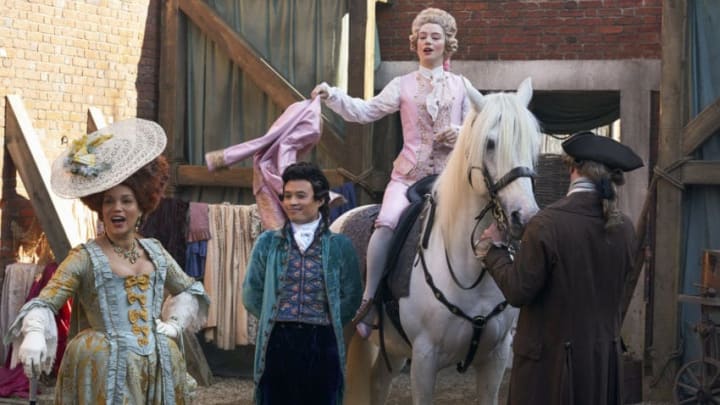Harlots co-creator Moira Buffini chats with Culturess about the second episode of season 3, including the reinvention of Lucy Wells and the brutal conditions facing Lydia Quigley.
The second episode of Harlots season 3 finds many of our main characters struggling to survive.
Charlotte must deal with the Pincher brothers’ attack on her home, a violation which brings many of the working women from their neighborhood together to help when the police refuse to do so.
Elsewhere, Lydia Quigley remains a virtual prisoner in Bedlam Hospital, and she and her new young protégé Catherine undergo frequent assaults – both of the physical and sexual varieties – in the name of mental health “treatment”.
Basically: It’s hard out here for a harlot.
However, the horrible situations in which many of our faves find themselves also provide opportunities for more complex and interesting stories.
We got the chance to ask Harlots co-creator Moira Buffini a bit about her thoughts on season 3’s second episode, and what the series’ characters are going through at the moment.
One of the most shocking storylines of season 3 thus far has to be Lydia’s imprisonment in the notorious Bedlam, an institution which appears to exist to torture women as much as to help them. (Or, rather, the definition of “help” in a place like this is extremely messed up.)
Lydia and her new protégé – a young woman by the name of Catherine who has found herself committed for enjoying the act of unmarried sex too much – face a variety of horrors. Both are physically and emotionally abused by the hospital’s staff, and poor Kate is repeatedly sexually assaulted by a doctor who claims to be “treating” her.
These graphic sequences are difficult to watch, to be sure, but they are not in any way inaccurate.
According to Buffini, the Harlots team did their homework about what conditions were like in an institution such as this, and the (horrifically) vague conditions it took for a woman to end up there.
“Research gave us everything,” she explained. “We read quite a lot about what was done to the inmates of madhouses in the name of scientific progress. The rotational chair from Episode one was a real thing, as were the ice baths.”
“Even if you weren’t mad when you arrived in Bedlam, conditions were so appalling that few remained sane for long.”
And, as we’ve seen on the show, it took very little for a woman to wind up in such an institution.
“All it took to put a woman in a madhouse was the word of a male relative,” Buffini said, a fact that is illustrated in the show by Charles’ decision to have his mother committed despite the fact that she had never, up until the point of her intake, displayed any behavior that might be categorized as madness.
Of course, “madness” in women of consequence often looks an awful like “power,” “wealth” or “the desire to make one’s own choices” if you ask me.
Even Lydia Quigley, as awful as she is – and she’s an accessory to murder, so she’s pretty terrible – deserves better than this fate.
Thankfully, Harlots has “chosen to tell stories of fortitude,” according to Buffini. And therefore Lydia’s time in Bedlam is not only blessedly limited, but includes some measure of vengeance for the terrible things that have happened to her.
The presence of Kate is also an unexpected gift for Lydia.
“Kate’s arrival in Bedlam gives her the will to escape,” Buffini says. “Lydia sees Kate as angel. And Kate sees Lydia as her savior. [They] forge a bond in hell.”
However, just because the two women free themselves from the madhouse, that doesn’t mean things will be smooth sailing for Lydia and her new charge just yet. “Bedlam will leave its scars on them both,” Buffini warns.
Also, there’s the whole thing where they’re currently broke and homeless, but one problem at a time, I suppose.
Season 3’s second episode also shows us a side to Lucy Wells we’ve never really seen before – the hardened businesswoman. The shift makes a nice change after all the violence that Lucy’s experienced at the hands of men – men who were supposed to provide her with a path to freedom and financial independence, but instead trapped her in darkness and despair.
This version of Lucy seems relatively free of a lot of that baggage, and it’s a refreshing change.
“A recurrent theme in Harlots is how people deal with damage,” Buffini said. “There’s a version of Lucy who could have taken all the damage inwards and been permanently weakened by her experience with George Howard and Lord Fallon. But the version of Lucy that interested us most was the girl who chose to become stronger – and harder.”
“There’s a brittle ferocity to Lucy now; a strong sense of self-preservation,” Buffini continued. “The fear with her is that she’ll send the damage outwards.”
New episodes of Harlots stream Wednesdays on Hulu.
